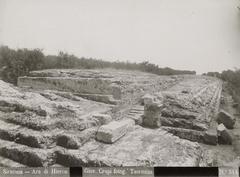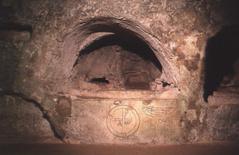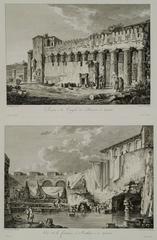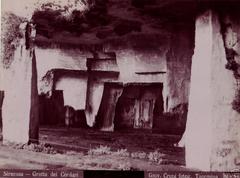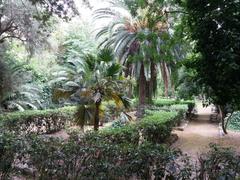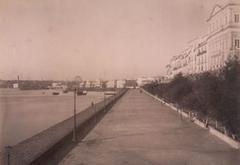
Madonna delle Lacrime Sanctuary Syracuse: Visiting Hours, Tickets, and Complete Travel Guide
Date: 04/07/2025
Introduction
The Madonna delle Lacrime Sanctuary in Syracuse, Sicily, stands as an extraordinary testament to faith, modern architecture, and the living history of the region. Renowned for the miraculous weeping of a Madonna statue in 1953, this sanctuary draws pilgrims, tourists, and architecture enthusiasts alike. This guide provides a comprehensive overview of the sanctuary’s origins, architectural features, visiting hours, ticketing, accessibility, and nearby Syracuse historical sites, ensuring a meaningful and well-planned visit (SiracusaCulture.com; CatholicShrineBasilica.com).
Table of Contents
- Origins of the Madonna delle Lacrime Phenomenon
- Construction and Architectural Significance
- Visiting the Sanctuary: Essential Information
- Museum of Lacrimation and Relics
- Frequently Asked Questions (FAQ)
- Conclusion & Further Resources
Origins of the Madonna delle Lacrime Phenomenon
The Miracle of the Weeping Madonna
In late August and early September 1953, a modest plaster bas-relief of the Madonna and Child in the home of Antonina and Angelo Iannuso began to shed what appeared to be real human tears (SiracusaCulture.com). Hundreds witnessed the phenomenon, and the tears were chemically analyzed by a medical commission, confirming their similarity to human tears (EnjoySicilia.it; CatholicShrineBasilica.com).
This event quickly gained national and international attention, bringing an influx of pilgrims and sparking widespread devotion. The original site at Via degli Orti 11 is now an oratory, while the miraculous image is enshrined above the sanctuary’s main altar.
Ecclesiastical Recognition and Societal Impact
On December 13, 1953—Saint Lucy’s feast day—the Catholic Church officially recognized the miracle. The endorsement elevated the event from a local curiosity to a focal point for Marian devotion, making Syracuse a major pilgrimage destination (SiracusaCulture.com).
Construction and Architectural Significance
Design, Engineering, and Symbolism
The sanctuary’s iconic teardrop-shaped design was conceived by French architects Michel Andrault and Pierre Parat after an international competition. Constructed between 1966 and 1994, the structure stands 103 meters tall, making it the tallest building in Syracuse. Its conical form, visible from across the city, was intended to symbolize a tear falling from heaven—an architectural homage to the miracle that inspired its creation (Modernist Pilgrimage).
Renowned engineer Riccardo Morandi oversaw the complex construction, which features seismic-resistant elements and a radial pattern of concrete ribs. The sanctuary can accommodate up to 11,000 standing or 6,000 seated worshippers, emphasizing its importance as a major pilgrimage site (Wikipedia; Algila.it).
Archaeological Discoveries
Excavations during construction uncovered ancient Greek and Roman tombs, as well as a paleo-Christian mausoleum, reflecting Syracuse’s rich archaeological heritage (History Hit). Many of these artifacts are now housed in the Paolo Orsi Archaeological Museum (Paolo Orsi Archaeological Museum Official Site).
Visiting the Sanctuary: Essential Information
Location and Getting There
- Address: Via del Santuario, 33, 96100 Siracusa SR, Italy
- Getting There: The sanctuary is centrally located and easily accessible by car, local buses, or on foot from the city center. Ample parking is available nearby, but it can fill up during peak times (Triphobo).
Visiting Hours and Mass Schedule
- April to September: 9:00 AM – 7:00 PM
- October to March: 9:00 AM – 5:00 PM
- Sunday & Solemnities Masses: 08:00, 10:00, 12:00, 17:30, 19:00, 20:00
- Monday to Saturday Masses: 08:00, 10:00, 19:00
- Confessions: Daily, 10:00–12:00 and 17:00–19:00
Note: Special celebrations and feast days may affect these hours; always check the official sanctuary website for updates.
Tickets and Admission
- General Entry: Free for worshippers and casual visitors.
- Guided Tours: May require advance booking and a small fee for in-depth experiences.
- Museum Entry: Included with sanctuary admission; donations are appreciated.
Accessibility and Facilities
- Wheelchair Accessible: Ramps and elevators connect all levels.
- Facilities: Restrooms, a visitor center, a gift shop, and free Wi-Fi near the entrance.
- Services for Hearing Impaired: Masses in Italian Sign Language are regularly offered (GiovanniDallOrto.com).
Guided Tours and Special Events
- Guided Tours: Available in multiple languages by request; provide historical, architectural, and spiritual insights.
- Special Events: The annual Feast of Our Lady of Tears (August 29), monthly Marian prayers (28th), and processions (29th) are particularly significant (CatholicShrineBasilica.com).
Dress Code and Visitor Etiquette
- Dress Modestly: Cover shoulders and knees; hats off inside.
- Silence and Respect: Maintain quiet during Mass and prayer times.
- Photography: Allowed, but no flash during services, and always be discreet.
Best Photographic Spots
- Exterior: The teardrop silhouette from the front plaza or Via Elorina.
- Interior: The upper church’s ceiling and the miraculous image.
- Archaeology: The preserved ancient Greek road on the lower level.
Museum of Lacrimation and Relics
The Museum of Lacrimation, located in the crypt, documents the 1953 miracle with original photographs, scientific instruments, relics (including crystallized tears), and ex-voto offerings like crutches and back-braces from those who reported healing (Algila.it; EnjoySicilia.it). The museum also commemorates Pope John Paul II’s consecration of the sanctuary in 1994.
Nearby Syracuse Historical Sites
Combine your visit with other remarkable destinations:
- Paolo Orsi Archaeological Museum: Extensive collection of Greek and Roman artifacts.
- Church of Santa Lucia al Sepolcro: Site associated with Syracuse’s patron saint.
- Greek Theatre and Archaeological Park: Ancient ruins a short walk away.
- Ortigia Island: Historic heart of Syracuse with temples, markets, and sea views (ReidsItaly.com).
Frequently Asked Questions (FAQ)
Q: What are the Madonna delle Lacrime sanctuary’s visiting hours?
A: Generally 9:00 AM–7:00 PM (summer), 9:00 AM–5:00 PM (winter); check the official website for updates.
Q: Is there an entrance fee?
A: Entry is free; donations are appreciated.
Q: Is the site accessible for people with disabilities?
A: Yes, ramps and elevators are available throughout the sanctuary.
Q: Are guided tours available?
A: Yes, by prior arrangement; inquire at the visitor center or via email.
Q: Can I take photographs?
A: Yes, but be discreet and avoid flash during services.
Q: What is the best way to combine a visit to the sanctuary with other Syracuse historical sites?
A: Plan a walking or bus tour including the sanctuary, the archaeological park, and Ortigia Island.
Conclusion
The Madonna delle Lacrime Sanctuary is a unique destination where faith, architecture, and history converge. From the tears that inspired a global pilgrimage to the modernist structure that crowns Syracuse’s skyline, the sanctuary offers a compelling experience for both spiritual seekers and cultural explorers. Plan your visit around the sanctuary’s hours, take advantage of guided tours, and explore nearby Syracuse historical sites to enrich your journey.
For the latest information, audio guides, and travel updates, download the Audiala app and follow our channels for more on Sicily’s sacred landmarks.
Sources
- SiracusaCulture.com - Sanctuary of the Madonna of Tears
- ReidsItaly.com - Madonna delle Lacrime
- CatholicShrineBasilica.com - Santuario Madonna delle Lacrime Syracuse
- Modernist Pilgrimage - Basilica of the Madonna delle Lacrime
- History Hit - Syracuse Archaeological Site
- EnjoySicilia.it - Santuario Madonna delle Lacrime
- Paolo Orsi Archaeological Museum Official Site

